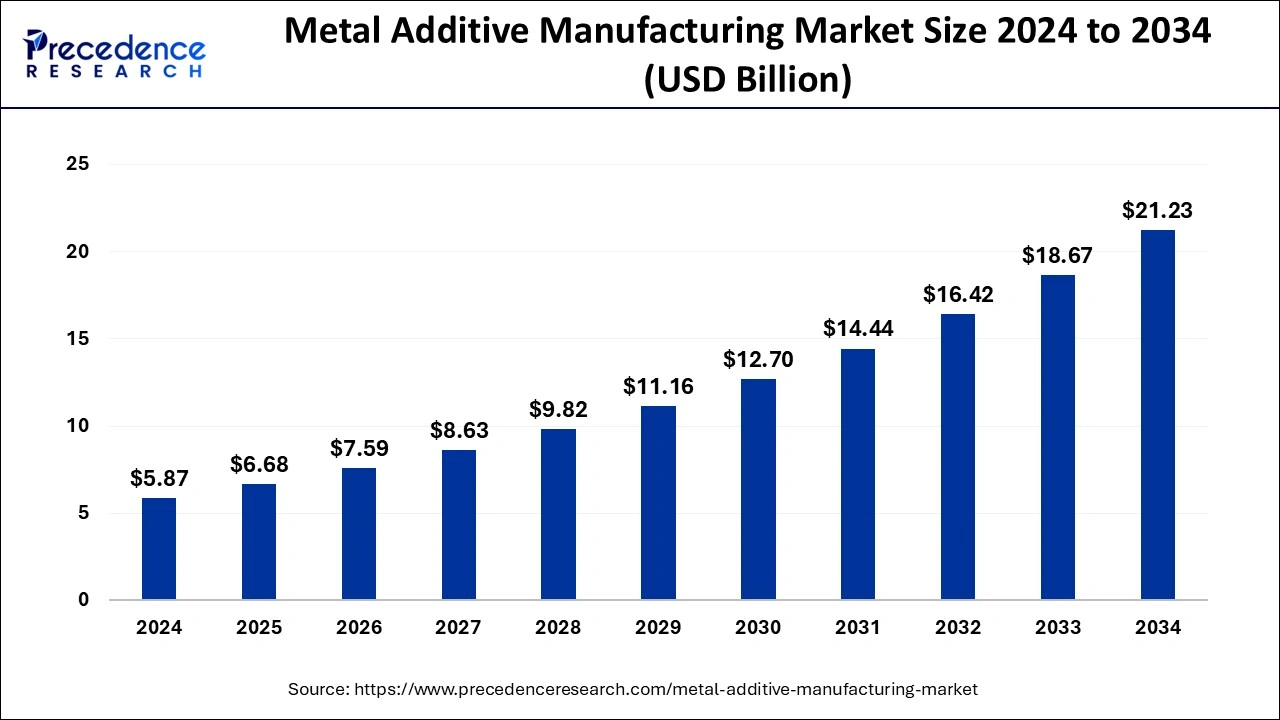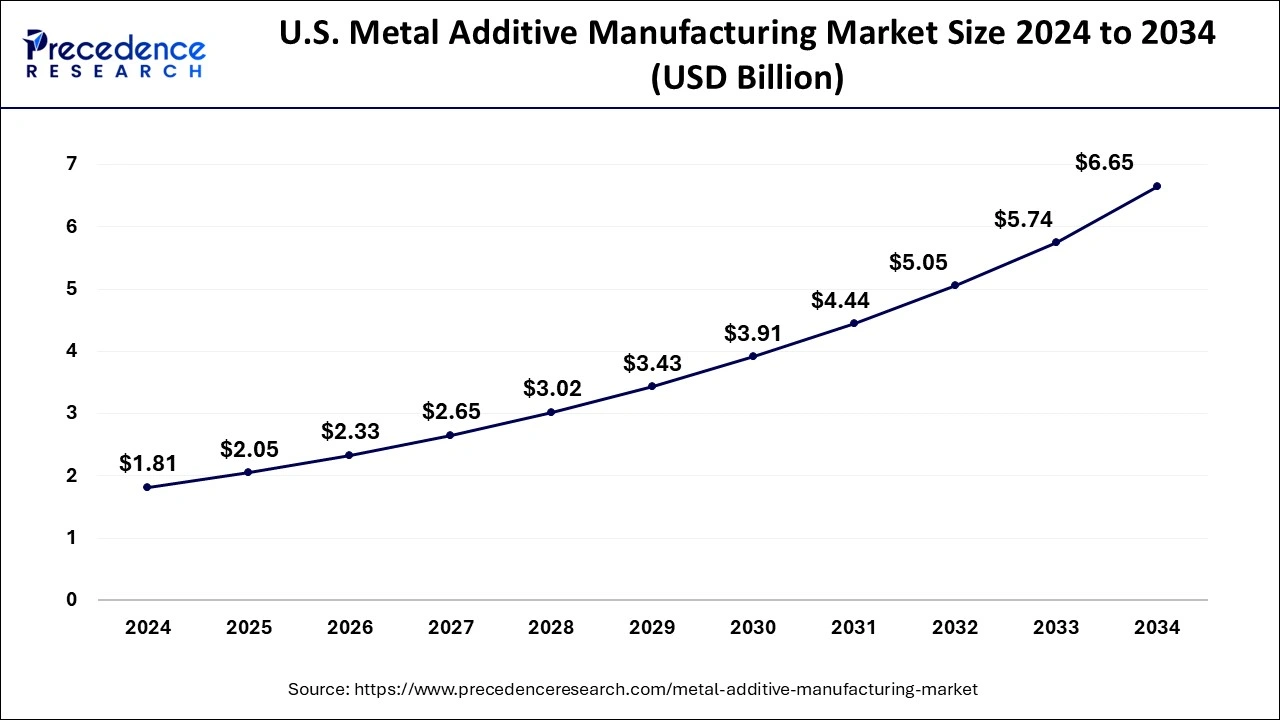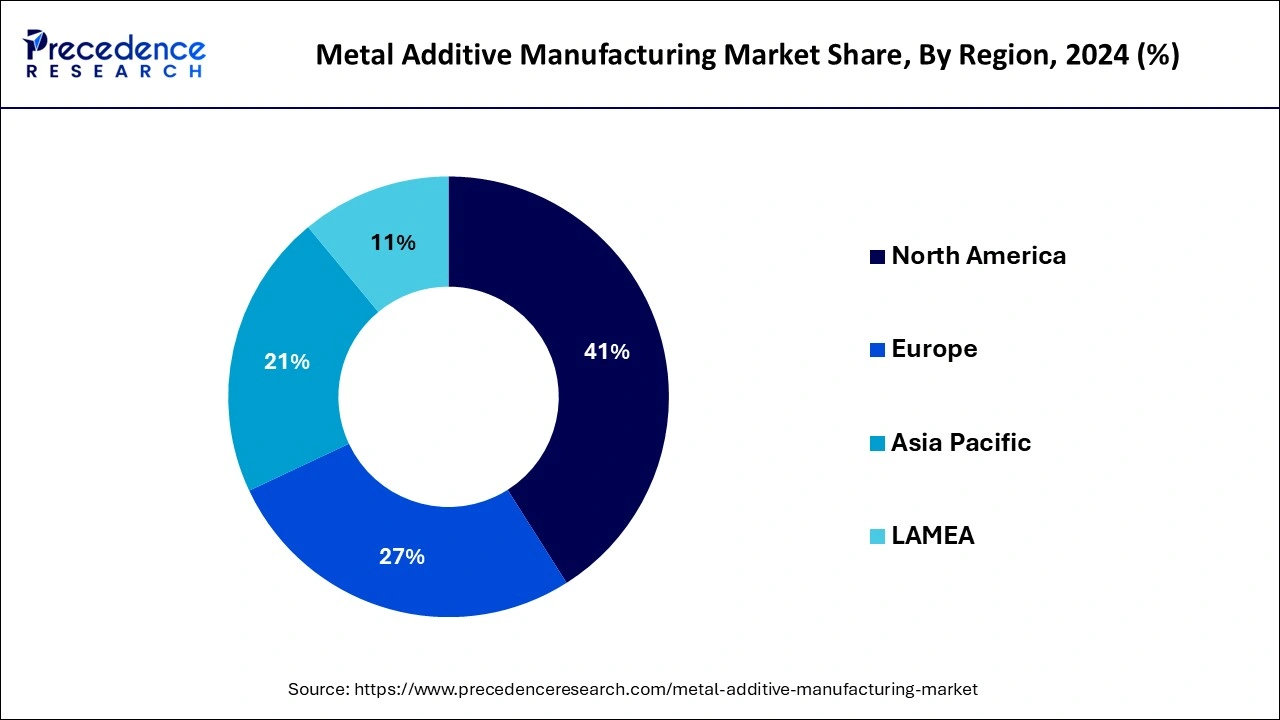List of Contents
What is the Metal Additive Manufacturing Market Size?
The global metal additive manufacturing market size is estimated at USD 6.68 billion in 2025 and is anticipated to reach around USD 21.23 billion by 2034, expanding at a CAGR of 13.72% from 2025 to 2034.

Metal Additive Manufacturing Market Key Takeaways
- North America dominated the global market with the largest market share of 41% in 2024.
- By types, the selective laser melting segment is projected to grow at a fastest CAGR during the forecast period.
- By application, the automotive industry segment generated the biggest market share in 2024.
Market Overview
The increased use of new products and adoption of metal additive manufacturing technologies in various industries like the aerospace industry healthcare and dental industry, automotive industry, academic industry are the reasons why the market is growing. This metal which is formed is in continuous motion on a conveyor belt. Various benefits are offered by the metal additive manufacturing over the traditional metalworking methods. There are many different types of technologies which are used in the metal additive manufacturing systems. Most of these technologies are available for use today.
The global pandemic had a negative impact on the market. Due to various restrictions and lockdown of most industries the market was down. There was a massive decline in the construction, aerospace and automotive sectors due to this pandemic. Due to the delayed logistical solutions and disrupted supply chains there were massive disruptions in the manufacturing and transportation which had a great impact on the market growth. Furthermore the lack of competent labor in combination with the long term plant shutdowns hampers the market. There was a severe shortage of raw materials as the pandemic progressed.
Metal Additive Manufacturing MarketGrowth Factors
Due to an increase in the demand for consumer electronics the market is expected to grow. The objects in the additive manufacturing are developed layer by layer which are extremely thin and which happens to make the manufacturing of these products stable and extremely lightweight. There's an increasing demand for these wearable devices. As an increasing demand and the growing interest in consumer electronics, smart wearable devices, video game consoles, smartphones and mixed reality devices the demand for the additive manufacturing solutions is expected to grow during the forecast period.
One of the industry leaders Phone Skope Used a photo centric additive manufacturing system to produce custom molded adapters. According to the consumer technology association there shall be an increase in the revenue of the retail sales for EU S tech industry the demand for appliances and consumer electronics is also expected to grow in the future. Due to an increasing demand for electronics the hardware production has also increased. Due to an increased demand of electronics in India the demand for hardware is estimated to reach dollars 400 billion. There's an increase in the demand for consumer electronics in many countries like India as well as US. Due to the usage of 3D printing technologies to develop improved methods which are new for the market and integration for the ultra accurate production of new high performance electronic devices is also expected to drive the market growth.
Nano dimension collaborated with Fraunhofer institute for manufacturing engineering and automation and this collaboration will work to investigate and produce innovative freeform 3D printing and gathering procedures for the production of electromechanical systems. The metal additive manufacturing technologies are critical drivers for the innovation for various businesses. These Technologies are not only extremely ideal for building bespoke components but also for rapid prototyping. It is also used in the formation of various geometrical figures which are extremely difficult or impossible to construct with the help of the conventional technologies.
The metal power bed fusion technology is largely used in the present times for additively manufacturing high performance components. in case of the metal additive manufacturing the cost of entry is less. Affordable industrial quality printers are the common materials used. Prototyping is easier as it does not consume a lot of time. The expense of the additive manufacturing prototype is comparatively cheap. Julie there is a requirement for a mold in order to manufacture about thousands of products of a single kind. But with the use of this technology it will be done in a lesser amount of time. Additive manufacturing market small batch manufacturers gain a lot. Traditional manufacturing processes usually have a warehouse stacked with a lot of parts which one needed for replacements. But the additive manufacturing technology has a virtual inventory.
The information is stored in the cloud throughout the lifecycle of the product and it can be printed on demand. Therefore it helps in removing the space needed for warehouses, personnel and the space needed for obsolete parts extremely easy to recreate and optimize the legacy parts required in any industry. Previously if the machines that manufactured a certain part stopped functioning there would be a loss of customer trust. This will hamper the sales and loyalty of the consumers. This is not the case with the use of additive manufacturing. This technology will help in recreating it in a 3D printer. Design engineers have started using artificial intelligence driven generative design for creating new products. By setting the constraints many suggestions can be drawn by the systems which will be able to meet the requirements. The desires then need to select the perfect design and produce the shapes.
Market Scope
| Report Coverage | Details |
| Market Size by 2025 | USD 6.68 Billion |
| Market Size by 2026 | USD 7.59 Billion |
| Market Size by 2034 | USD 21.23 Billion |
| Growth Rate from 2025 to 2034 | CAGR of 13.72% |
| Largest Market | North America |
| Base Year | 2024 |
| Forecast Period | 2025 to 2034 |
| Segments Covered | Type, Application, Geography. |
Types Insights
On the basis of the types the selective laser melting segment is expected to grow well during the forecast period. Selective laser melting is a manufacturing technology that makes use of laser to fuse the powdered materials into various 3 dimensional objects. Only the top layer it's printed by the SLA prints. the top layer is off powder adhered to its platform which provides minimal support if necessary. This procedure can also be done with the help of metal powders and raisins contrary to the traditional plastic filament. Selective laser melting is a good process which helps in creating high resolution and low volume parts. This method is extensively used in prototyping and production applications.
Apart from the selective laser melting segment the electron beam melting segment is also expected to grow well during the forecast period. This is another type of additive manufacturing process where the metal powder bed fusion process takes place. The electron beam melts the material with the support of high energy electrons which provide penetration depth in order to melt the deepest layers at a single shot.
Application Insights
The automotive industry is the application segment which is expected to show the largest market growth during the forecast period. The metal additive manufacturing is used in automotive industry to manufacture parts, components and prototypes. These prototypes should be strong enough for testing purposes. This is extremely helpful in reducing the overall time required for manufacturing and building of the cars as well as the vehicles and it is extremely helpful as it provides superior quality products when compared with the other conventional manufacturing methods used for building cars.
The aerospace industry also has several uses of metal additive manufacturing. The most common use of metal additive manufacturing is to produce the components that can be useful for the aircraft or the spacecraft. The additive manufacturing process does not need any tooling or equipment and hence it is the most effective solution for making complex shapes at a minimal cost. Another important use of metal additive manufacturing in the aerospace industry is the replacing of the broken parts which could be an expensive affair. In case there is a requirement for replacement of the parts they can be easily made through the metal additive manufacturing processes which help in saving the time as it has faster production capabilities compared to other ways.
Metal additive manufacturing is also used in the dental industry and the healthcare industry. They are used to create customized implants. The production is done by the usage of metal powder which is obtained from different technologies like SLM and EBM. There is a micro structural control over all elements which are used for creation and designing of implant. The roughness and the geometry of the implant surface is maintained due to the event dispersion of particles. This technology one by one by makes it possible to provide a better fit for patients by reducing increased friction at the hip joints and provides better performance after the surgeries.
Regional Insights
U.S. Metal Additive Manufacturing Market Size and Growth 2025 to 2034
The U.S. metal additive manufacturing market size is evaluated at USD 2.05 billion in 2025 and is predicted to be worth around USD 6.65 billion by 2034, rising at a CAGR of 13.89% from 2025 to 2034.

The North American market is expected to hold the largest market share during the forecast period. Followed by the North American market the Latin American market is also expected to be the fastest growing market for the global metal additive manufacturing. The Asia Pacific market is estimated to have the significant growth in terms of revenue. Due to the increased industrialization and increasing demand for the automotive industries in countries like Japan, China, India and South Korea the market is expected to grow.
How North America Dominates in Metal Additive Manufacturing?
North America has the largest share of global metal additive manufacturing due to increased industrial adoption of technologies by many companies in the aerospace, defense, automobile, and healthcare industries. North America has also invested heavily in research and development (R&D) as well as commercializing metal additive manufacturing technology before any other region and supporting governments in promoting and enabling advanced manufacturing technology. North America also has the most suppliers of metal additive manufacturing systems and services, as well as the largest concentration of companies and downstream suppliers, providing a robust ecosystem for metal additive manufacturing technologies to operate. North America has continually pushed to develop new technologies and respond to dramatic changes in production from the digital revolution.

The third largest market for the global metal additive manufacturing is the European market. Some economics could prove to be extremely beneficial for the growth of the international metal additive manufacturing market. It includes Italy, UK, Germany, Japan China and the US. Adoption of metal additive manufacturing is growing in many developing as well as the developed nations in a large range of industries across these countries including the military. There are good amount of growth opportunities which could increase the market in these various developed as well as the developing nations which will help in providing a boost for this market.
How Asia Pacific has the Region with the Highest Potential Growth Rate?
Asia Pacific is experiencing the highest potential growth rate worldwide for metal additive manufacturing. The growth rate in Asia Pacific is primarily due to several countries within the region (China, Japan, South Korea, and India) investing in modernization, resulting in increased use of metal additive manufacturing technology across various industries such as electronics, automobile, and industrial machinery. A major driver of this growth is affordable production capabilities, coupled with a growing talent pool and governmental support of digitalization. With local companies quickly ramping up their production capabilities within this region, the Asia Pacific region will become a major growth area for MAM technology.
Why Is Europe Is a Region of Healthy Growth?
Europe continues to grow steadily with a strong commitment to engineering, sustainability and high-quality manufacturing. Metal additive manufacturing (3D printing) is being incorporated into the aerospace, automotive, and energy industries to provide lightweight, complex parts. Many European countries have also begun to support the adoption of metal additive manufacturing due to regulations promoting low-waste and efficient manufacturing practices. Germany, France and the U.K. are experiencing significant growth in industrial 3D printing capabilities, making Europe a leader in innovation and a strong market in the future.
Why Is the Middle East & Africa an Emerging Market?
In the Middle East and Africa, metal additive manufacturing is gradually being implemented into various new industries as they continue to evolve and expand. As industrialization progresses within many regions, including the UAE and Saudi Arabia, the growth of metal additive manufacturing is being driven by investments in these regions specifically toward the aerospace, oil and gas, and construction industries due to their interest in utilizing this technology to 3D print customized, protective and durable parts.
The Middle East and Africa are still in the early stages of developing metal additive manufacturing; however, with increasing awareness of current metal additive manufacturing technologies, newly developed strategies to implement them, and additional plans for industry growth, the Middle East and Africa position themselves as an emerging market with long-term growth and profitability potential.
Metal Additive Manufacturing Market Companies
- EOS GmbH
- BeAM Machines
- Wuhan Huake 3D
- GE Additive
- SLM Solutions
- 3D Systems
- Trumpf
- Renishaw
- DMG Mori
- Sisma
- Xact Metal
- Farsoon Technologies
- Bright Laser Technologies
Recent Developments
- The major collaboration between JAWS Spitfire and VELO3D is expected to encourage VELO3D's position as a trusted partner for other industries who are seeking novel manufacturing options for producing complex designs which prove to be a great challenge for the industry. After the success of the merger which is agreed on, it is estimated to take place in the later half of 2021. The merged industry will function under the name of VELO3D, and it will be listed on the New York Stock Exchange (NYSE) under the new ticker symbol of “VLD.”
- Markforged's Metal X is billed as an “end-to-end solution” for the complex metal parts.
- A system which is developed by 3DEO, that promises to be unique, is a dubbed Intelligent Layering, begins with six different steps to grant these high quality parts at a rate that is competitive with CNC machining and metal injection molding (MIM) at manufacturing numbers. The system supplies a premium surface quality and tolerances than any other metal AM process in the market.
Segments covered in the report
By Type
- Selective Laser Melting (SLM)
- Electron Beam Melting (EBM)
- Powder Bed Fusion
- Sheet Lamination
- Directed Energy Deposition
- Binder Jetting
By Application
- Automotive Industry
- Aerospace Industry
- Healthcare & Dental Industry
- Tools and Mold
- Academic Institutions
- Others
By Geography
- North America
- U.S.
- Canada
- Europe
- U.K.
- Germany
- France
- Asia-Pacific
- China
- India
- Japan
- South Korea
- Malaysia
- Philippines
- Latin America
- Brazil
- Rest of Latin America
- Middle East & Africa (MEA)
- GCC
- North Africa
- South Africa
- Rest of the Middle East & Africa
For inquiries regarding discounts, bulk purchases, or customization requests, please contact us at sales@precedenceresearch.com
Frequently Asked Questions
Ask For Sample
No cookie-cutter, only authentic analysis – take the 1st step to become a Precedence Research client